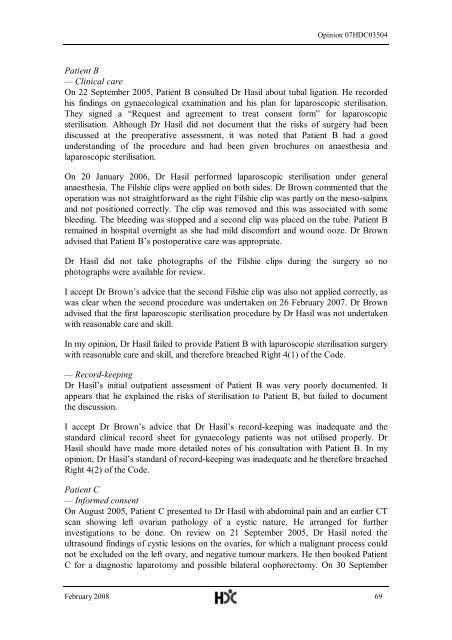Roman Hasil and the Whanganui DHB - Health and Disability ...
Roman Hasil and the Whanganui DHB - Health and Disability ...
Roman Hasil and the Whanganui DHB - Health and Disability ...
Create successful ePaper yourself
Turn your PDF publications into a flip-book with our unique Google optimized e-Paper software.
Opinion 07HDC03504<br />
Patient B<br />
— Clinical care<br />
On 22 September 2005, Patient B consulted Dr <strong>Hasil</strong> about tubal ligation. He recorded<br />
his findings on gynaecological examination <strong>and</strong> his plan for laparoscopic sterilisation.<br />
They signed a “Request <strong>and</strong> agreement to treat consent form” for laparoscopic<br />
sterilisation. Although Dr <strong>Hasil</strong> did not document that <strong>the</strong> risks of surgery had been<br />
discussed at <strong>the</strong> preoperative assessment, it was noted that Patient B had a good<br />
underst<strong>and</strong>ing of <strong>the</strong> procedure <strong>and</strong> had been given brochures on anaes<strong>the</strong>sia <strong>and</strong><br />
laparoscopic sterilisation.<br />
On 20 January 2006, Dr <strong>Hasil</strong> performed laparoscopic sterilisation under general<br />
anaes<strong>the</strong>sia. The Filshie clips were applied on both sides. Dr Brown commented that <strong>the</strong><br />
operation was not straightforward as <strong>the</strong> right Filshie clip was partly on <strong>the</strong> meso-salpinx<br />
<strong>and</strong> not positioned correctly. The clip was removed <strong>and</strong> this was associated with some<br />
bleeding. The bleeding was stopped <strong>and</strong> a second clip was placed on <strong>the</strong> tube. Patient B<br />
remained in hospital overnight as she had mild discomfort <strong>and</strong> wound ooze. Dr Brown<br />
advised that Patient B’s postoperative care was appropriate.<br />
Dr <strong>Hasil</strong> did not take photographs of <strong>the</strong> Filshie clips during <strong>the</strong> surgery so no<br />
photographs were available for review.<br />
I accept Dr Brown’s advice that <strong>the</strong> second Filshie clip was also not applied correctly, as<br />
was clear when <strong>the</strong> second procedure was undertaken on 26 February 2007. Dr Brown<br />
advised that <strong>the</strong> first laparoscopic sterilisation procedure by Dr <strong>Hasil</strong> was not undertaken<br />
with reasonable care <strong>and</strong> skill.<br />
In my opinion, Dr <strong>Hasil</strong> failed to provide Patient B with laparoscopic sterilisation surgery<br />
with reasonable care <strong>and</strong> skill, <strong>and</strong> <strong>the</strong>refore breached Right 4(1) of <strong>the</strong> Code.<br />
— Record-keeping<br />
Dr <strong>Hasil</strong>’s initial outpatient assessment of Patient B was very poorly documented. It<br />
appears that he explained <strong>the</strong> risks of sterilisation to Patient B, but failed to document<br />
<strong>the</strong> discussion.<br />
I accept Dr Brown’s advice that Dr <strong>Hasil</strong>’s record-keeping was inadequate <strong>and</strong> <strong>the</strong><br />
st<strong>and</strong>ard clinical record sheet for gynaecology patients was not utilised properly. Dr<br />
<strong>Hasil</strong> should have made more detailed notes of his consultation with Patient B. In my<br />
opinion, Dr <strong>Hasil</strong>’s st<strong>and</strong>ard of record-keeping was inadequate <strong>and</strong> he <strong>the</strong>refore breached<br />
Right 4(2) of <strong>the</strong> Code.<br />
Patient C<br />
— Informed consent<br />
On August 2005, Patient C presented to Dr <strong>Hasil</strong> with abdominal pain <strong>and</strong> an earlier CT<br />
scan showing left ovarian pathology of a cystic nature. He arranged for fur<strong>the</strong>r<br />
investigations to be done. On review on 21 September 2005, Dr <strong>Hasil</strong> noted <strong>the</strong><br />
ultrasound findings of cystic lesions on <strong>the</strong> ovaries, for which a malignant process could<br />
not be excluded on <strong>the</strong> left ovary, <strong>and</strong> negative tumour markers. He <strong>the</strong>n booked Patient<br />
C for a diagnostic laparotomy <strong>and</strong> possible bilateral oophorectomy. On 30 September<br />
February 2008 69

















